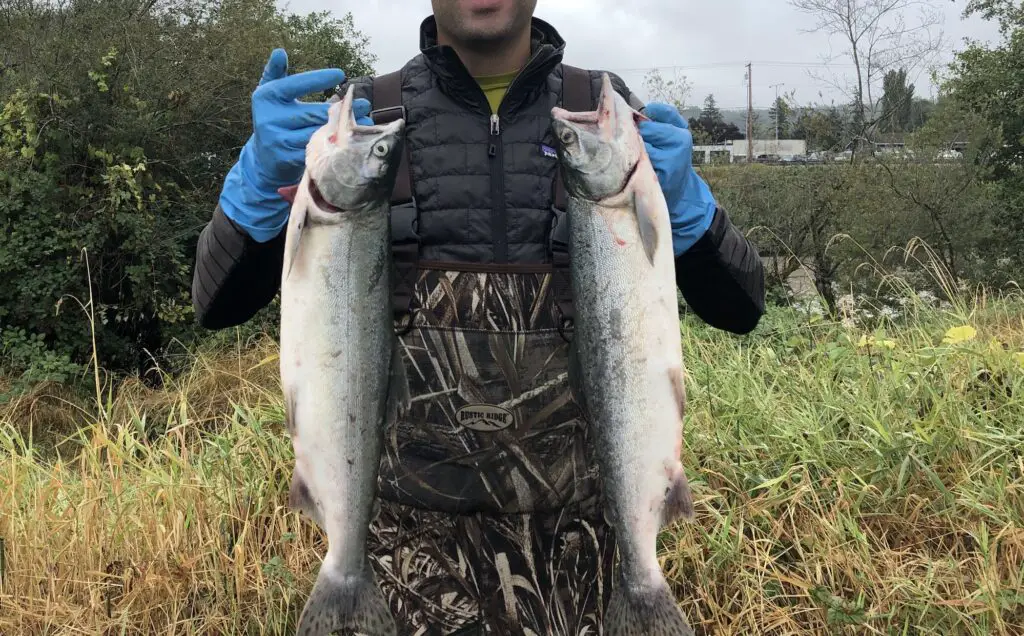
The Pinks are coming! The Pinks are coming! Odd years in the PNW conjure up images of millions of salmon flooding our rivers, enough to get the experienced and novice angler eagerly anticipating the month of August.
We reveal the secrets to success, fishing the best rivers for pink salmon.
I will never forget my first experience fishing for pink salmon in the Puyallup River. It was August and the Pink run that year was epic!
You could almost walk across the river on the pink salmon. I hadn’t even bought a pair of waders yet, but there I was shivering in the glacial melt cold waters of the Puyallup in my jeans and t-shirt.
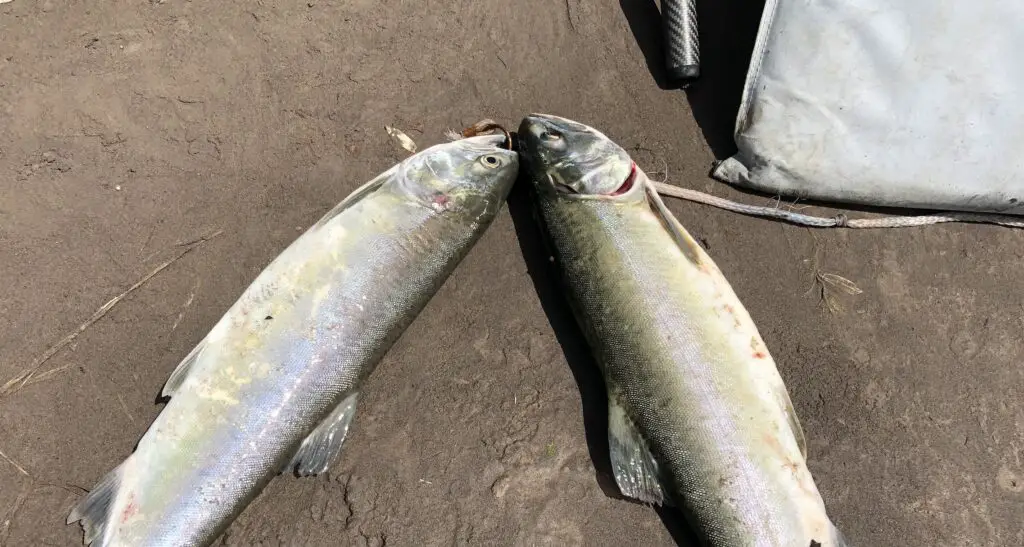
I had literally no clue what I was doing. I had grown up fishing the lowland lakes of western and eastern Washington for trout and bass, but never salmon and never in the rivers. Yet my brother, my Dad, and I were all catching our limit of pink salmon.
While I could blow right through this topic and arm you with just enough details to get on the river and catch your limit on a good return year…that’s not what we do here at PNWBestLife!
We are going to dive in-depth into this topic in a hopefully reader-friendly way that will enable you to become: *dramatic music*, a master pink salmon angler!
Pink salmon are also known as “Humpies” to many. This is because as the males mature and get closer to spawning they will develop quite pronounced humps. Early on in the season, in the saltwater or near river mouths, pink salmon will be difficult to identify this way.
Humpies / Pink Salmon are the smallest of the five Pacific salmon species that return to North American rivers. And, they have the shortest lifecycle. Every two years a full lifecycle from fry to spawning will take place, which is why the run of pinks occurs every two years.
There are even year pinks as well, but these are far less numerous in Washington.
For information about the year 2023 run of pink salmon, take a look at this blog post.
Rigging up for Pink (Humpy) Salmon Fishing
It doesn’t matter what river you are fishing for pink salmon at, having the right setup is important.
Pink salmon are the smallest of the five salmon species, but pound for pound they can put up a great fight.
But just like you don’t take your meat stick trout fishing, leave the heavy stuff at home when it comes to pink salmon fishing.
Why can’t I bring my heavy tackle to the river to catch some stinky pinkies? Well, it’s about 10x the fun if you have properly sized gear.
It’s also always important to match your gear to your technique, but in general, go with a rod/reel / mainline combo that is closer to what you would use for steelhead fishing in the rivers vs salmon.
I cannot go too much further here without recommending this excellent guide to buying a rod for river salmon fishing.
In fact, the first rod/reel mentioned is a perfect setup to get you started with pinks in any river. You can also visit our page dedicated to helping you buy an appropriate fishing reel for salmon or steelhead.
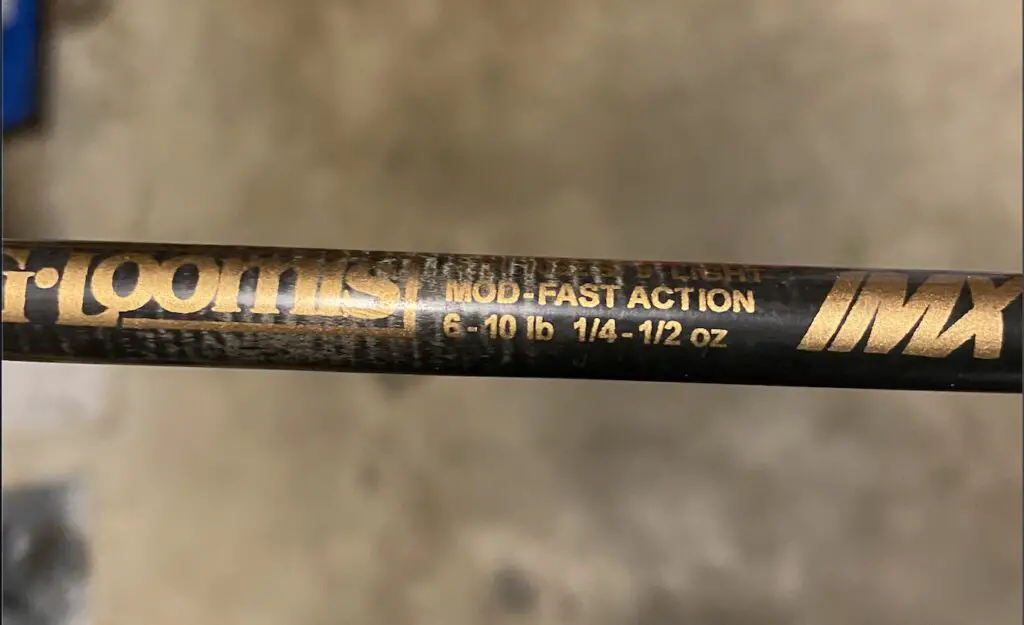
I like to fish for pink salmon with a fishing rod with these ratings: 6-12 lb, 1/4 to 1/2 oz lure weight that is 8’6-9’6 in length.
The rod action will be something like ML for Medium Light, but you can also go lighter and still land these fish (and have lots of fun!).
Fighting a pink salmon in the river on medium-light gear is a lot of fun! You can get away with lighter, but at some point, and especially in combat fishing your fellow angler may get impatient with your “epic battle with a pink salmon on light gear”.
More specifics on rigging up will be covered later on as we discuss each technique that’s appropriate for pink salmon fishing depending on a number of factors.
How to catch Pink Salmon (Humpies)
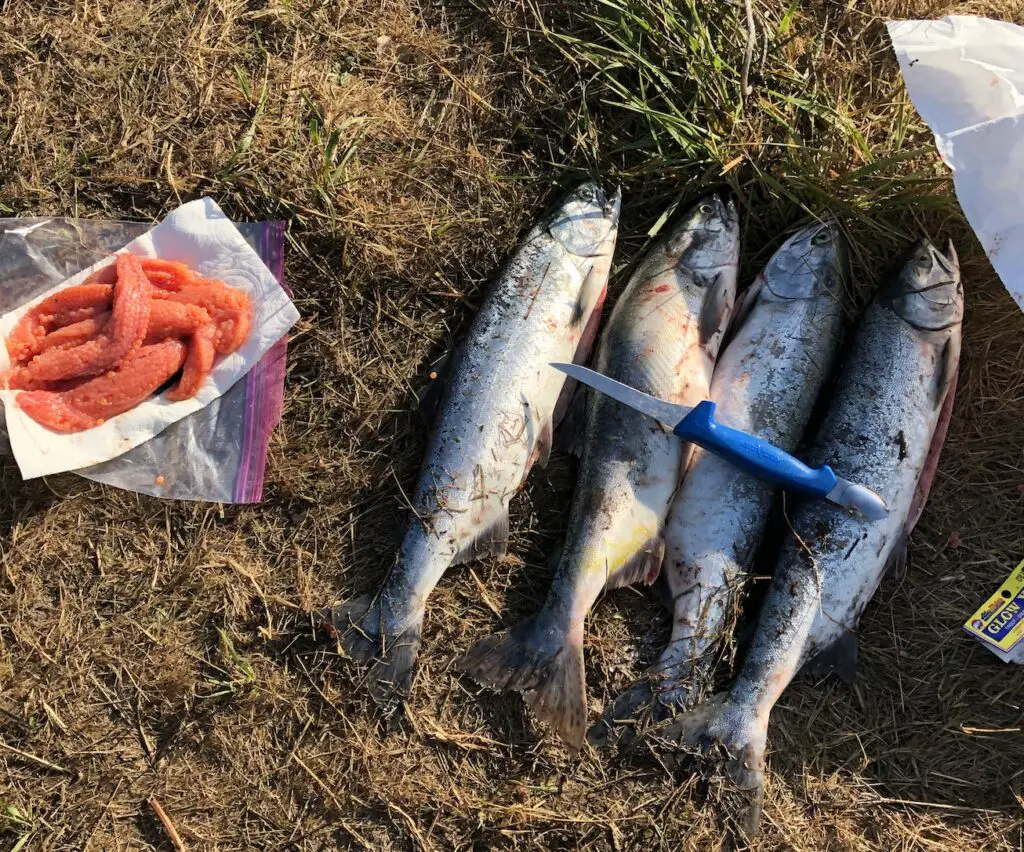
Let’s talk techniques for catching these incredibly fun pink salmon.
There are a variety of salmon fishing techniques that work, but the river you fish for pink salmon on will determine which fishing technique is most appropriate.
Why is that?
Two concepts that are important here:
- River visibility – Pink Salmon are incredibly aggressive due to their early lifecycle spent in large schools of other fry competing for resources. This is part of what makes them so much fun to fish for! However, a Pink Salmon that cannot see your fast darting offering, is not going to be an aggressive biter.
- River temperature – Like all other salmon (fish?), the water temperature will often play a role in the aggressiveness of behavior based on the size of the offering. The warmer the river water, oftentimes the smaller the offering needs to be, to get bit.
Let’s talk about a few examples:
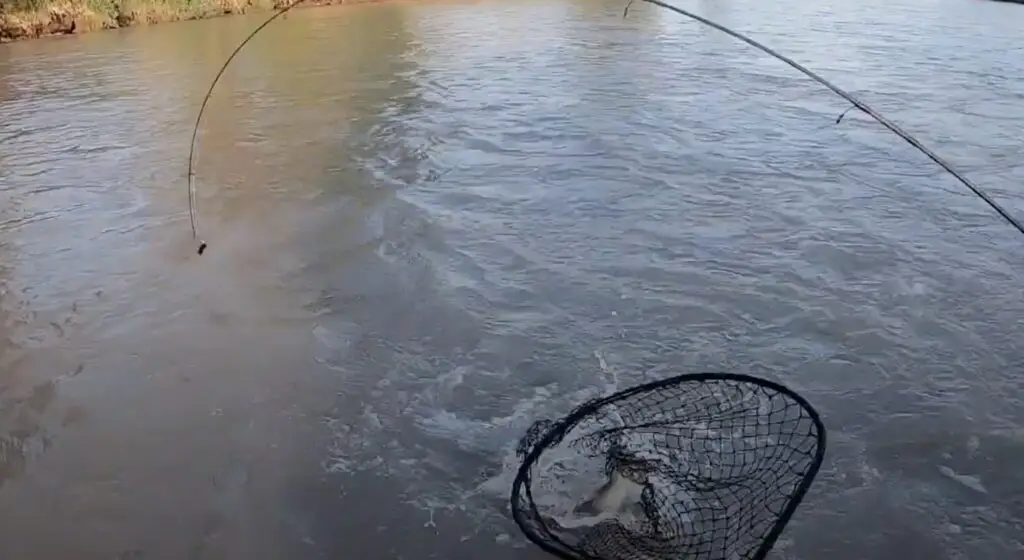
The Puyallup River near where I live has about 1″ of visibility during the summer months.
Why is that? The source of the Puyallup River is the glaciers of Mount Rainier combined with many high-elevation springs/runoff.
During the summer, other sources of water run low, leaving the primary source of water as the melting glaciers.
Melting glacier water is filled with incredibly fine particles known as silt or glacial till. You will see this on any river that is glacial melt-fed.
There will be a coloration to the water that may give it a light green to grey/brown look depending on what % of the water comes from the glacier vs other sources.
The primary pink salmon fishing technique in the Puyallup River for Pink Salmon is called drift fishing. I’ve written an extensive guide to drift fishing for salmon here.
Drift fishing is an important fishing technique on the Puyallup River due to its low visibility. Drift fishing attempts to slow down the speed of an offering by allowing the weight to periodically tick the bottom.
An adaptation to drift fishing is called drift flossing or just flossing for salmon, another topic I’ve written about here. Flossing is another popular fishing technique used for Pink Salmon in the Puyallup River due to the low visibility, but it’s definitely not the only way to hook these salmon.
Let’s contrast this fishing technique to the Nisqually River.
While the Nisqually is also glacially fed, it has a massive dam on it which forms the Alder Lake reservoir. The glacial silt settles in the reservoir allowing mostly clear water to be released from the dam.
This water is quite cold and allows the use of some of my favorite fishing techniques such as throwing spinners or twitching jigs for pink salmon.
Again, the Snohomish River is another example of a clear water river, but also where water temperature matters.
Early on in the season (August), the water temperatures will be higher, which results in smaller lures like dick nites being the preferred choice for pink salmon fishing.
After the first rains in rivers like the Green and Snohomish, pink salmon become much more aggressive on a variety of offerings.
The river you fish, determines HOW you fish for pink salmon
I’ve written extensively about river fishing for salmon on this page if you want more details on topics such as reading water and understanding river fishing for salmon better.
Drift Fishing for Pink Salmon
There are a variety of drift fishing leaders that will work for Pink Salmon.
The important thing is that the hook is presented at or near the eye level of the fish. With low visibility glacial silt rivers, they will not travel far, so if the offering isn’t right in front of their face, you won’t get bit.
To achieve the correct presentation level, you need to balance hook size, leader length and corkie / cheater size.
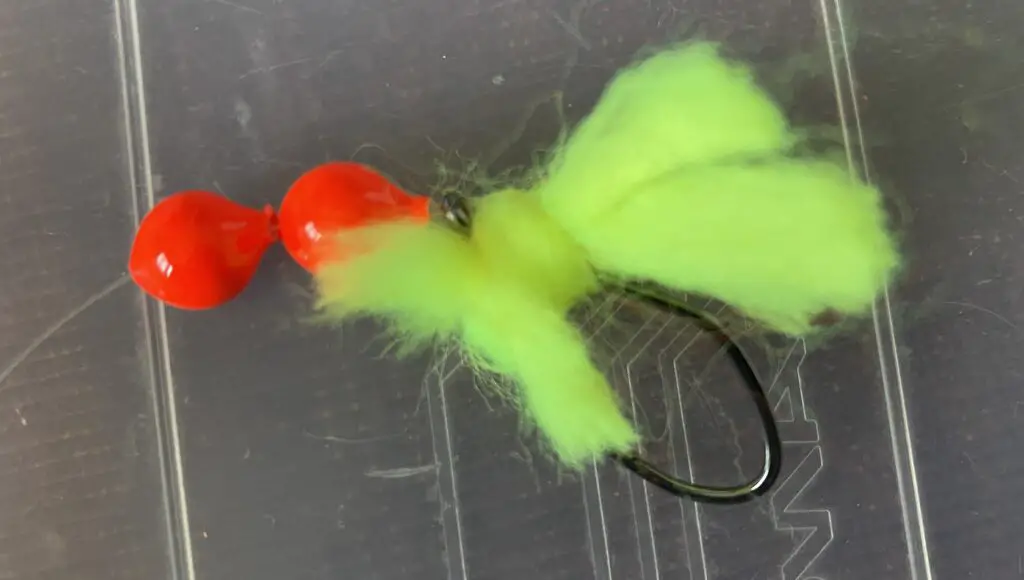
I started using these double size 12 corkie rigs with chartreuse yarn and size 1/0 hooks because of the larger profile/contrast which helps visibility.
If you are just starting out, fish for pink salmon with something you know is going to work and then experiment from there.
I tie the above rig on a 3-4 ft leader.
You can tip your drift leaders (and your waiters! Waders?) with a little bit of shrimp (okay not your waiters), or apply scents like krill, shrimp, etc to get additional “bites”, but more often than not, due to numbers, the pink salmon you hook will be flossed.
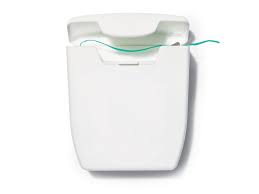
Yes, you will see people with 6 ft+ leaders who are attempting to be more effective at flossing or to imitate those they saw catching more pink salmon, but the reality is that it’s still quite unnecessary to have that long of a leader to hook pink salmon on just about every cast when the run is in on the Puyallup.
You will want to check out my in-depth post on drift fishing for salmon for more details on the drift fishing technique.
Spinner Fishing for Pink Salmon
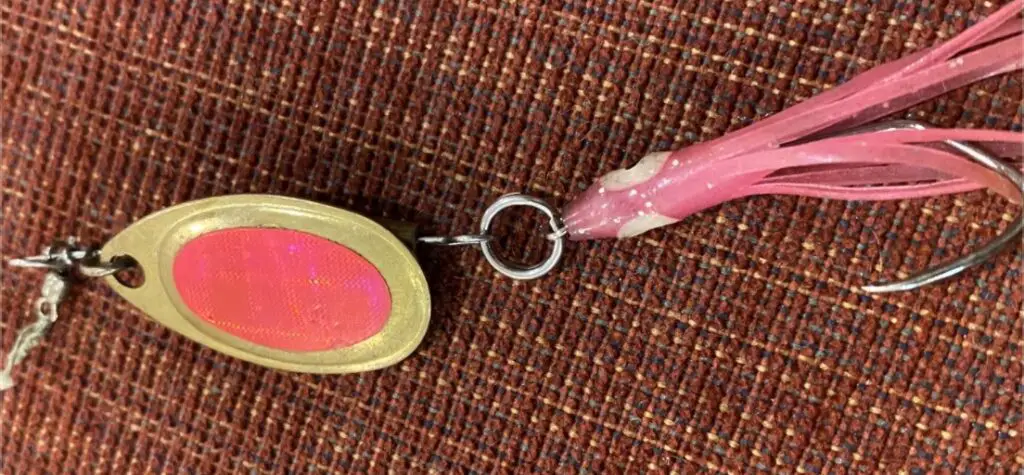
Spinner fishing has got to be my favorite way to catch pink salmon.
There’s nothing like the adrenaline-pumping action of feeling a pink salmon strike a spinner or spoon you have a direction connection with.
I’ve hooked pink salmon in the Puyallup on spinners, but it’s not easy, and the reality is you may end up foul hooking more of them when they are in thick.
When the water provides decent visibility and temperature, however, it’s tough to beat the slow sweeping presentation of a squid spinner with pink on it to hook numerous pink salmon.
There’s much to write about salmon fishing with spinners and really more than what I can capture in this page focussed on pink salmon fishing.
You are going to want to find areas of slower current that pink salmon hold in when resting on their journey upriver.
A size 3 spinner is just about the right size for many of these holding areas I fish. I will cast just slightly upstream and let it sink for perhaps 2 seconds before I start to slowly reel in until I can feel my spinner.
The most important aspect of spinner fishing is being able to feel/see the thump-thump-thump of the spinner blade rotation on your rod tip.
If you can’t do this, you are just fishing blind and wasting your time. The goal is always to maintain that slow thump-thump-thump while presenting the spinner at the right depth in the water column.
Spinner fishing for salmon or steelhead can be incredibly challenging and technical, or it can be as simple as tossing it across the river and reeling in slowly until you get bit.
Luckily for the sake of the length of this article, most of the time pink salmon fishing is more like the latter. I’ve given complete newbies a rod with a spinner tied on, some basic instructions, and had them catch as many pinks as I could with the same tackle.
The sheer numbers and aggressiveness of pink salmon is what makes this type of fishing so much fun and easy.
Twitching Jigs for Pink Salmon
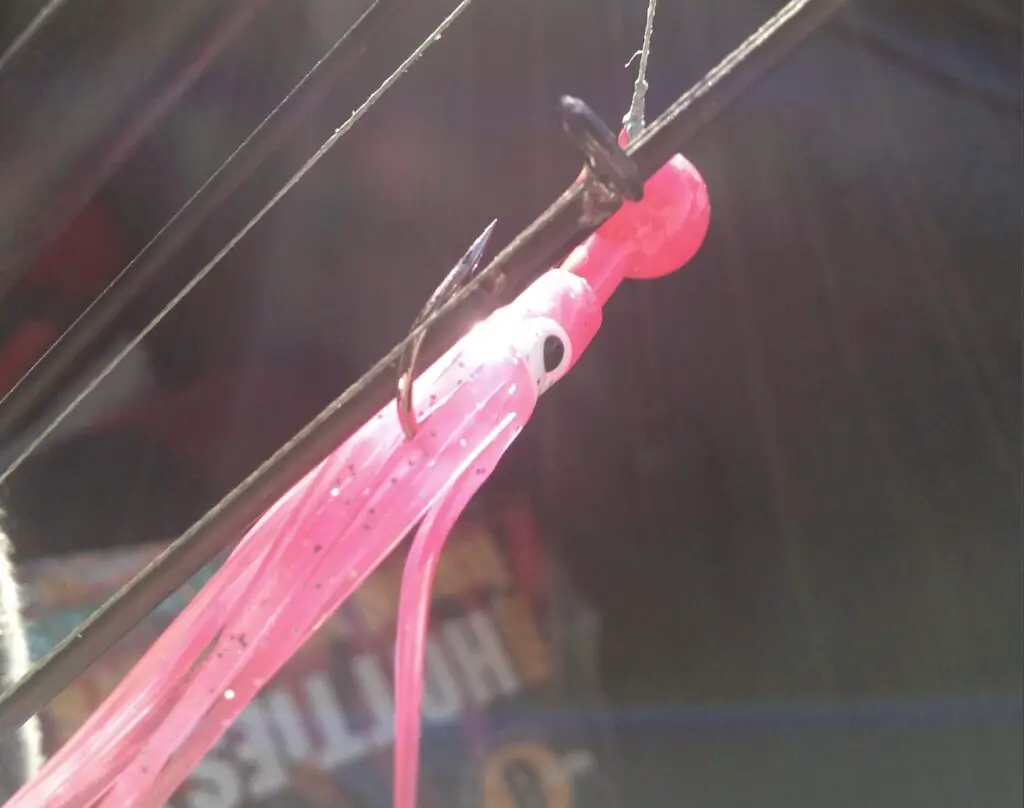
Have you heard about twitching jigs for coho or other species of salmon and wondered if you could have the same type of success? Well, pink salmon are the place to get started on this journey, if any salmon fishing is considered “easy”, this is it.
I will twitch jigs in very similar water that I will toss spinners in. There are two general twitching jig techniques based on the speed of the current:
- In frog water / with very little current you can let the jig fall until it hits the bottom or near the bottom. You then “twitch” the jig back to your casting position
- In more current, you can “swim” the jig across the current until the jig lies directly below your casting position, in which case you reel it back.
How to twitch a jig for pink salmon
In most cases you are going to make a jerking upward motion with the rod tip that brings the jig up 6-12″ up in the water column, followed by a rapid lowering of the rod tip which allows the jig to fall through the water column.
Most salmon will bite as the jig falls, but you won’t feel it until you lift the tip for the next “twitch”.
This is incredibly fun!
Generally, you will reel in some slack as the jig is falling, prior to your next twitch to ensure the jig generally makes its way up the water column and back to your position. Be careful not to take up too much slack though because if the jig doesn’t free fall, the salmon won’t bite it.
How to swim a jig for pink salmon
In this twitching technique, you will cast the jig directly across your position into the current, wait for a half-second, and then begin to make the slightly upward jerk motions, followed by immediately lowering your rod tip.
You may need a 3/8 oz or 1/2 oz jig to have the jig sink far enough as it sweeps across the current.
You do not take up slack in this method or the jig won’t drop deep enough to where the salmon are typically holding.
As the jig swings across the current, to below your position, you reel it back for your next cast.
Float Fishing for Pink Salmon
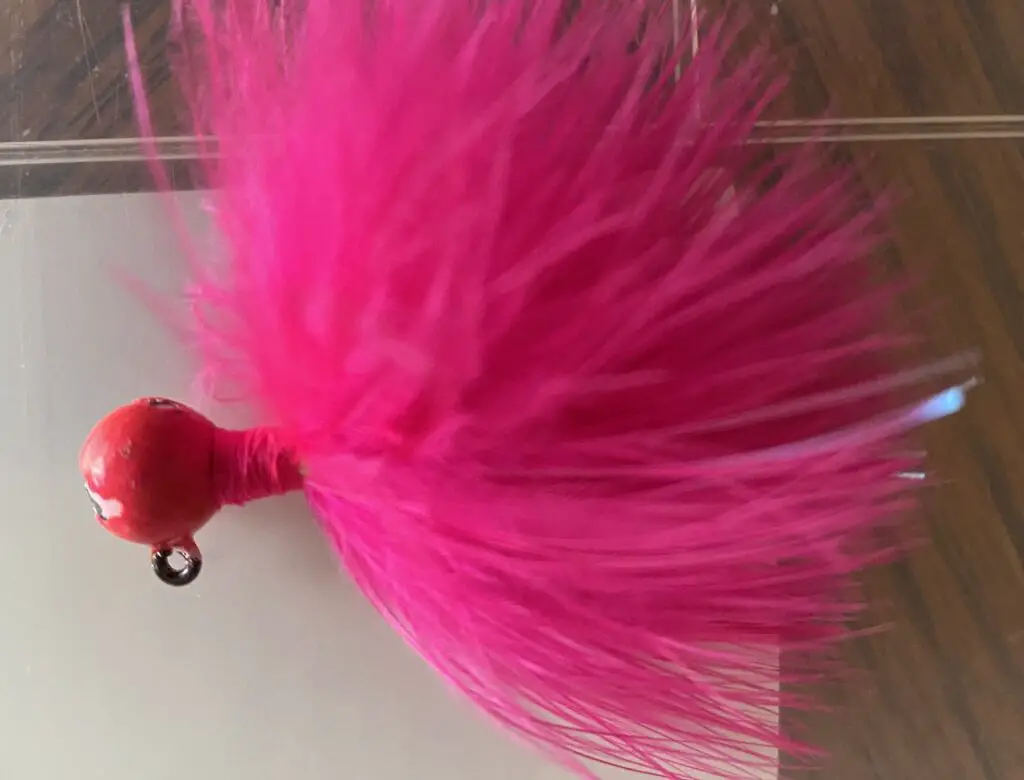
Float fishing is a great way to target really any species of salmon. Pink salmon are no exception here.
Generally, a pink jig, tipped with a little bit of shrimp will get the job done. Checkout my page fully dedicated to float fishing for more details on the technique.
Fishing Dick Nite’s for Pink Salmon
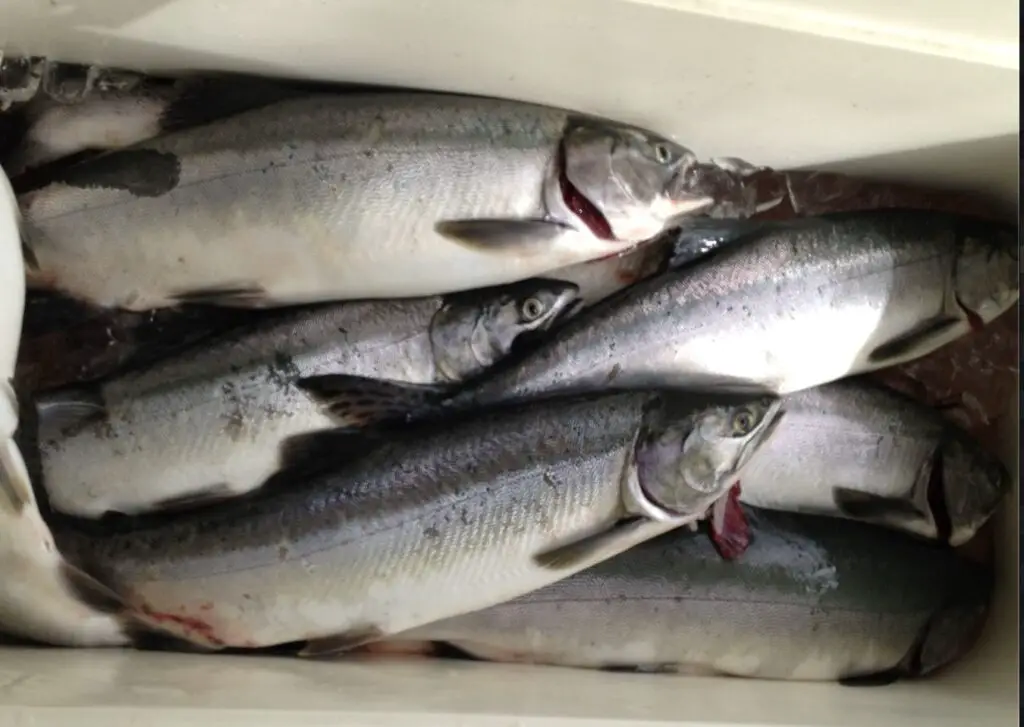
I’m not sure who started this whole program, but the first I was introduced to it, I hired a guide to take me and the kids to the Snohomish River to give them a pink salmon fishing experience that didn’t require wading and combat fishing.
We anchored in the drift and set up several rods with divers and these tiny dick nites on long leaders.
It couldn’t have been more than a few minutes before the action started. The pink salmon response to this technique was epic and we soon had a full boatload of pink salmon we had sorted through to only keep hens (for the eggs).
I will admit that I took this same technique to the Nisqually without nearly the same success, even though I was fishing the same type of water and maybe not as many pinks, but still enough of them.
I found the jigs and spinners to be far more effective.
While I don’t fish rivers like the Green or Snohomish as much as the Puyallup and Nisqually I know enough good anglers who do, and the common factor is the water temperatures in August where these dick nites work. And not just for pinks either! You will hook some number of coho and chinook doing this.
When to go pink salmon fishing?
Each river has a slightly different season for pink salmon based on when the regulations allow you to fish for them and when the salmon enter the river.
I catch my first pink off of a Puget Sound beach in the 3rd week of July. By the 2nd to 3rd week of August, the Pinks will start being caught in the rivers quite heavily, while the schools in the salt will completely overtake other species of salmon.
Consult the regulations for the river you aim to fish to figure out when you can start fishing for them.
Generally, you will be able to fish for pinks in the rivers all the way through September, and I’ve caught Pinks in the tributaries in the first half of October as well.
Best Lures for Pink Salmon (Humpies)
There are really quite a variety of lures that work for pink salmon, but again it depends on the technique you are using and the river you are fishing (covered above).
When you go to your local tackle store during the pink season you will see just about everything with pink on it being sold as “humpy lures”.
As an Amazon Associate, I earn a commission on any clickable product link. The price you pay is the same regardless, and you can support the blog by using these links to purchase.
Also, I should mention that I use many of these products myself or they wouldn’t be on the page. Finding the right products can sometimes be challenging, so hopefully these links help.
- Squid spinner – Add a squid skirt to your favorite spinner for use in rivers with good visibility water.
- Pink buzz bomb – Great in the salt water from the bank, replace the treble with a 1/0 hook and add the squid skirt to the hook.
- Squid Jig – Jig with these in the salt water or in a river with good visibility
- Dick nite – Start with size 0 50/50, but the frog and pink pattern work great as well. Use in rivers with good visibility and higher water temps, earlier in the season.
- Pink Spoon – Classic lure for pink salmon in rivers with good visibility, fish similar to a squid spinner for best results
- Pink jig – Fish under a float tipped with shrimp in rivers with good visibility.
Where to catch Pink Salmon in Western Washington
What kind of experience are you looking for? I know you will likely want to fish close to home, but you may have a very different experience on each of these rivers.
Is it important to you that you know the fish bit your offering (vs flossed)? Are you looking to try a technique like twitching jigs or tossing spinners? Perhaps the Puyallup is not what you want.
What about the number of fish? Do you want to hook a pink salmon on almost every cast, limit in 15 minutes, and sort through 50 pinks looking for one of the early coho? The Puyallup might be your river.
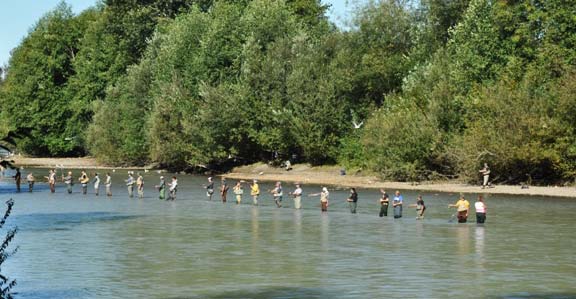
Are you looking to have some space for yourself? You might avoid the combat fishing zones on the Puyallup, Green, or Snohomish.
Puyallup River
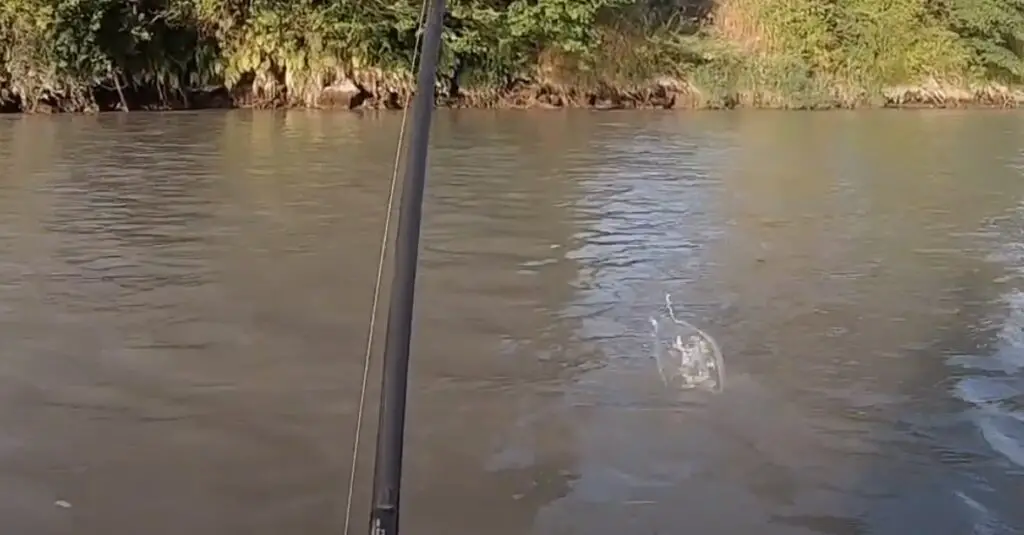
Glacial melt river that becomes so cloudy and colored up that there’s usually about 1-2″ of visibility. The Puyallup has the following main tributaries Pink salmon will head for: White and Carbon.
The Puyallup normally has one of the best runs of pink salmon in the Puget Sound basin and fast limits after the river opens (usually mid-August) are the norm.
Drift fishing is the go-to method on the Puyallup. Popular access spots can be easily spotted along Levy Road on the north side and River Road on the south side.
These spots will have many cars parked nearby which will make them easy to see. There are many areas you can have more space in as well, but you will need to walk the trails a bit.
Be extremely careful stepping into this river. With zero visibility, you have no idea how deep it is. Combine this dynamic with strong current, wearing waders and very cold water, can lead to dangerous conditions if you aren’t being careful.
The further up the river you go towards the town of Sumner and than south to Orting, the fewer people you will encounter.
Nisqually River
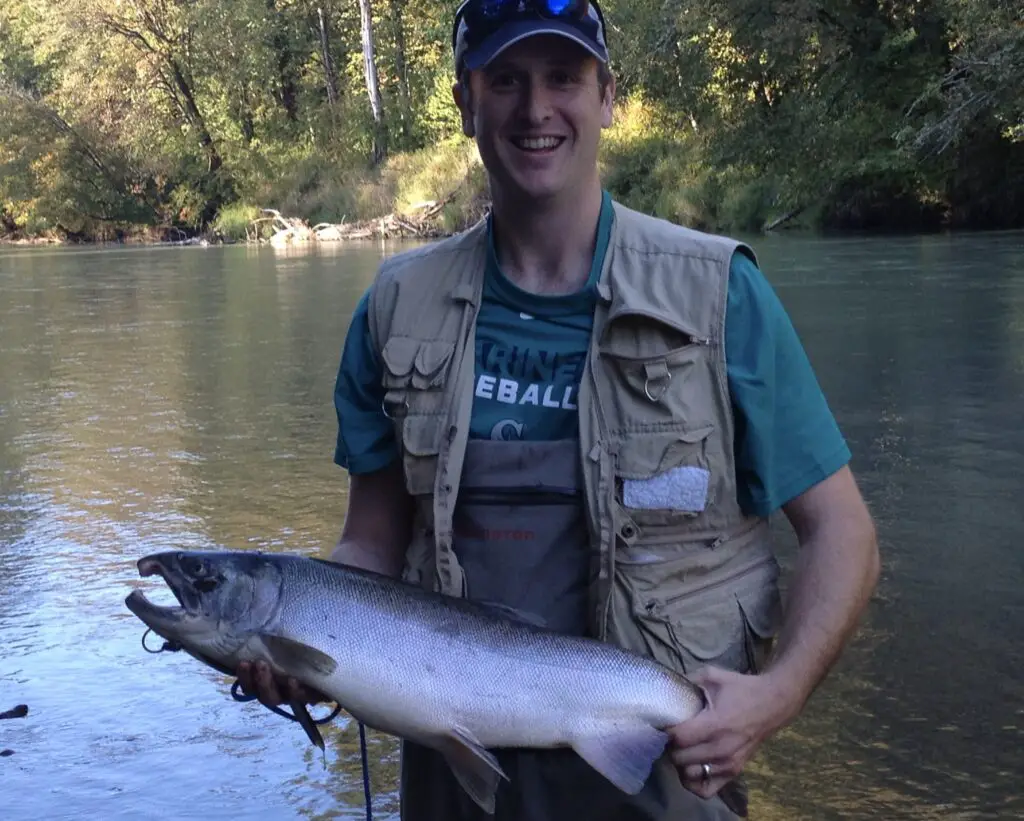
The Nisqually historically hasn’t had a great run of Pink Salmon and it got hit hard by the blob years of 2013-2017.
In 2023 however, the river bounced back with a strong return of Pink Salmon that was a lot of fun to fish for.
If you can find public access that is. Everyone knows the popular spots like Mounts Bridge, but you will need a JBLM recreational permit to fish the military side. There’s also the Riverbend campground, but you will have to pay to access it.
My favorite thing about the Nisqually is the cold clear water that usually provides for aggressive biting pink salmon. The pinks will usually come into the river a few weeks after the kings.
Keep in mind that on low snow pack years where the Alder Lake reservoir has less water, eventually the water being released from the dam will include glacial silt and you will have to alter your techniques to catch pink salmon.
Green River / Duwamish
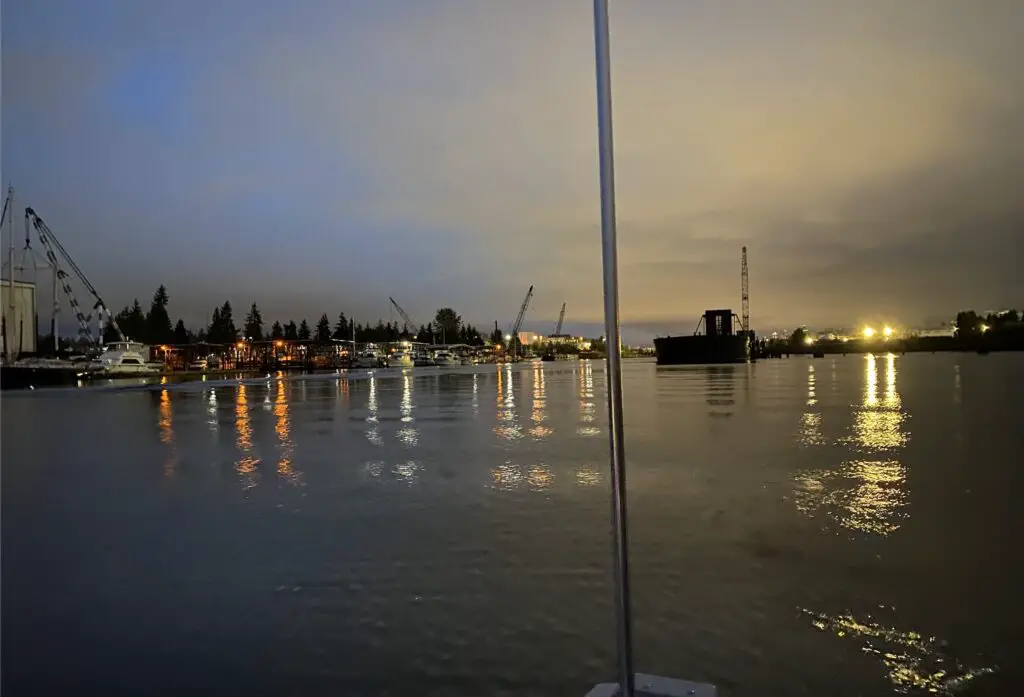
The Green / Duwamish River always runs clear but can get really warm in the lower stretch due to the distance of travel and lower flows during the summer.
There are a multitude of popular places to fish for Pinks, but I’m not prepared to share the specifics. Again, just like the Puyallup, drive the river and look for the parked vehicles. There’s not nearly as much public access compared to the Puyallup.
Try drifting dick nites early in the season, but try pink jigs as well.
Snohomish / Skykomish River
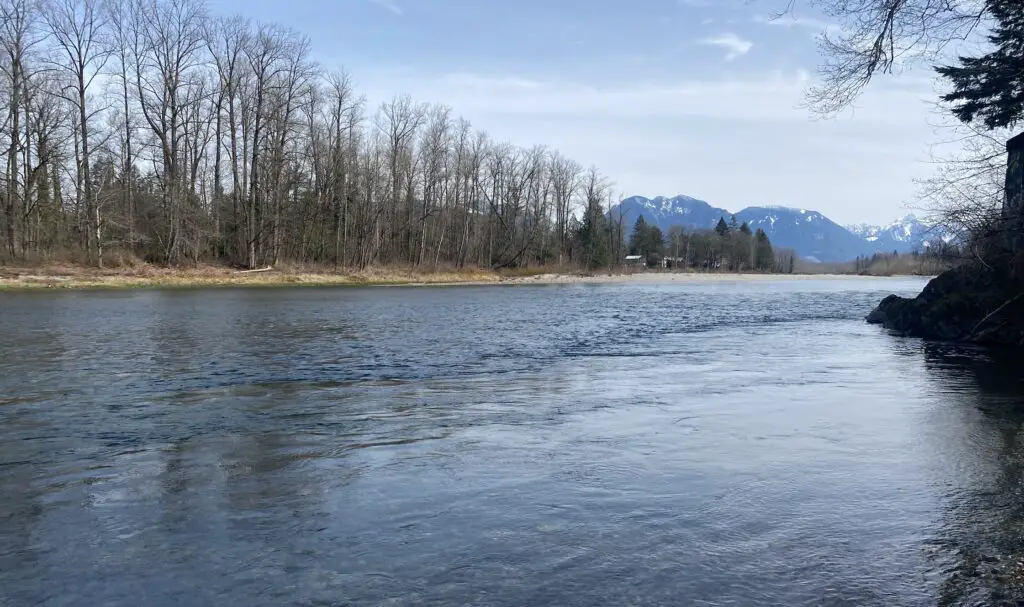
Honorable mention here because of its popularity, but not a river I’m very familiar with. I do know that the dick nite thing is money on this river whether from a boat or drifted from the bank.
Skagit River
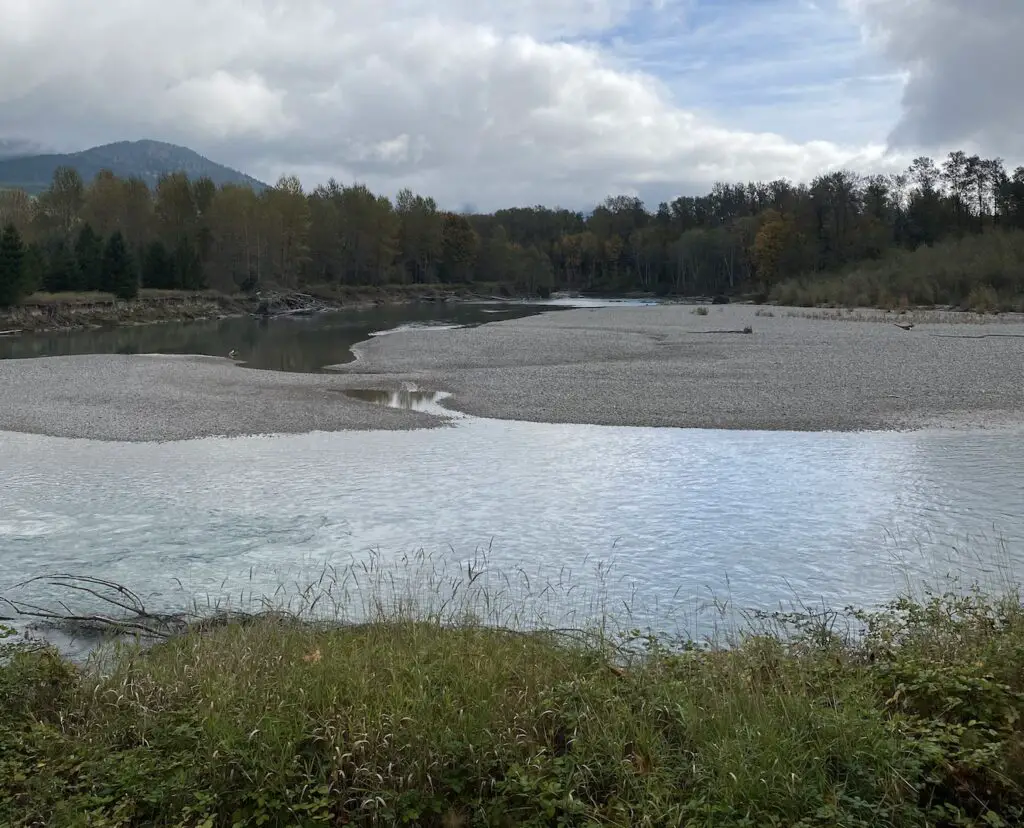
I’ve only fished the Skagit a few times, but it typically has a good run of pinks and provides most of the freshwater that flows into the Puget Sound.
I would leverage many of the same techniques on the Nisqually such as twitching jigs and tossing spinners here.
In the Puget Sound from the bank
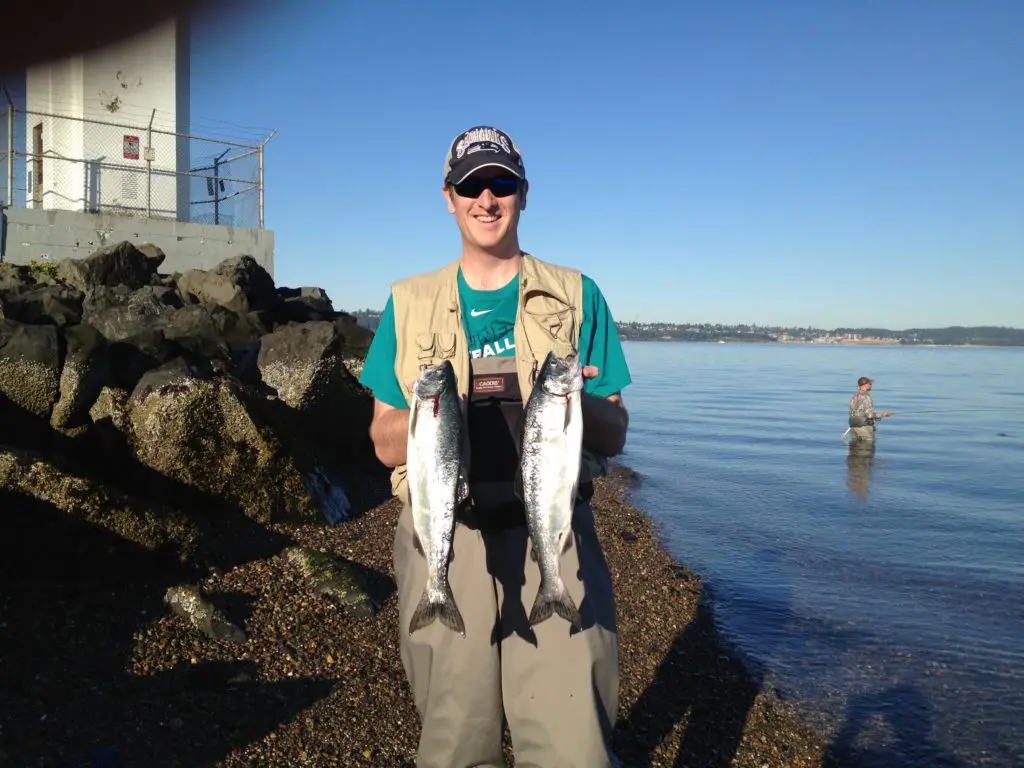
The same folks who are looking for a river to catch pinks in are going to be open to fishing the saltwater for pink salmon from the bank.
Long before our favorite rivers open for pink salmon fishing, you can wade into the sound a bit and throw a similar style of lures to catch pink salmon.
Fishing Dash Point or Brown’s Point are some of the most popular areas in the South Sound, but there are also many piers/beaches around Seattle (and further north) where you can do this quite effectively.
I tend to throw more buzz bombs or squid jigs due to their cast-ability
Eating Pink Salmon
Every year you will hear people scoff at the idea of eating pink salmon. And it’s true, I would prefer a fresh coho or king salmon fillet any day of the week.
However, pink salmon makes quality table fair IF it’s caught in the saltwater or very near the saltwater.
I like to fish for pinks in the river within 10 miles of a river’s mouth for the best results. A fresh pink salmon will look very bright chrome, and the meat will be pink/orange in hue.
While a fresh pink will do just fine on the BBQ, pink salmon have a bit more oil and softness to the meat than your coho of king salmon. This dynamic makes pink salmon the perfect fish to smoke.
Not only does the smoking process benefit greatly from the oily nature, smoking a pink salmon fillet will firm it up significantly creating a great end product that most cannot differentiate between king or coho smoked salmon.
Important etiquette rules for combat fishing during pink salmon fishing
So much of pink salmon fishing is done in “fishing combat zones”, but I don’t want you to be scared off by that and miss an incredible experience. If you follow a few rules of etiquette you should have no trouble fitting in right away.
Let’s start with approaching the line of fisherman. Often times newcomers will just try to fit in between with other anglers.
This is not the polite way to join the line. How do you know that the two anglers you got between didn’t intend to fish together? The polite way to do it is to go to the end of the line.
If there’s nowhere to fish except between two anglers AND it looks like there might be space the polite approach is to ask if you can slip in between them.
Oftentimes, they will let you in, other times they may say “It’s a little tight”.
There are many places to fish, so don’t feel bad about jumping back in your vehicle and finding another area.
The last time that happened to me, I ended up leaving a slow area and going to another river where I did quite well by myself.
Order of making a cast
When you are in the fishing combat line, there’s a specific order of casting that must be respected to ensure everyone’s line doesn’t get crossed.
That order is always that the downstream angler casts first. If the upstream angler goes ahead of the downstream angler, then the downstream angler has nowhere to cast.
When in doubt watch what everyone else is doing.
Also, if somebody downstream of you is messing with their line, you can just ask if they are going to cast, often times they will say “Go ahead”.
When a fish gets hooked
When a fish gets hooked by you or someone near you, it’s important to follow a few rules to make it easy for people to get back to fishing.
You want to call out “Fish on!” when you have a fish securely hooked.
The first 30-60 seconds of a fish being on will generally keep nearby anglers from casting. The further downstream the salmon runs, the more people that cannot cast without crossing the fishing line with the fish on it.
When the salmon you hook runs downstream like this, it’s important that you follow the fish downstream and out of the line of anglers, often by stepping forward and shouting “Fish on, coming down!”
Often times there will be chinook salmon running at the same time as pink salmon, and these salmon will take far longer to land and will always require walking downstream with them.
The goal is to play a salmon out of the main drift where people are casting, sometimes in the water right in front of the angler line or behind the line of anglers, or sometimes all the way downstream at the end of the line.
If you can control a pink salmon and bring it close enough to your position such that other anglers can now begin casting again, you don’t need to walk it downstream or step out of the combat fishing line.
If someone around you has a salmon on, you should not cast until it’s clear they have control of the fish.
I see forum posts or people on the river all the time complaining that someone crossed their line with a fish on yet these same people weren’t following protocol and walking their fish down.
If you are tying up the river for several minutes while you battle your pink salmon on a trout rod, people are people, they will get impatient and cast over you. And you could have prevented the situation.
You will see plenty of people on the river not following these unspoken rules, often because they don’t know. You can politely suggest any of these tips to help keep things efficient and civil.
Picking up trash
Every odd year, the one thing that marks the Pink Salmon Season more than anything is the significant amounts of trash left behind on the river.
I would love it if everyone packed out what they packed in, but we know that won’t be the case.
For those of us with our stuff together and who not only know better but have many years on the river, let’s add a trash bag to our fishing supplies and pick up stuff just on our way from the river to our vehicles.
How much cleaner will our rivers be? And so will the salt water that this trash will eventually be carried away too.
Wrapping up the Pink Salmon Fishing topic
I hope this blog page helps you this pink salmon fishing season.
If there’s a question or point of confusion, feel free to drop a comment here or email me at kyle@pnwbestlife.com.
I respond to all emails and comments. Sometimes a comment won’t appear right away due to spam filters, but I will get to it and once approved, your future comments on the blog will appear right away.